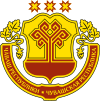This article includes a list of general references, but it lacks sufficient corresponding inline citations. (November 2024) |
| History of Tatarstan |
|---|
 |
| History of Chuvashia |
|---|
 |



Bulgarian epigraphic monuments[2][3][4] (Chuvash: Пăлхар эпиграфика палăкĕсем, Tatar: Болгар эпиграфика табылдыклары) - tombstones with inscriptions (epitaphs) of the 13th-14th centuries on the territory of the former Bulgarian ulus of the Golden Horde. The identified gravestones can be divided into several categories. From a "civilizational" point of view, there are such:
- Muslim[5]: 175–182 arabographic, of which there are currently about 400 pieces;
- Armenian[2]: 60–61 [6] ones with their own graphics, in the amount of 5 pieces and a few more obscure fragments; They also contain Arabic letters.
Muslim tombstones, in turn, can be classified according to language:
- only with Arabic text;
- having, in addition to Arabic, a text in some Turkic language
Depending on the type of Turkic language, the last group of monuments is divided as follows:
- tombstones in the Turkic language (r-language (this group is the largest);
- gravestones in Turkic z-language
There is also a classification based on the appearance of monuments, in accordance with their artistic features - 1st style and 2nd style.
Tombstones of the 1st style usually have text in z-language, and 2nd style - text in p-language. Therefore, it was initially believed that such a classification covers all the characteristics in a complex. However, there are exceptions to this correspondence.[7]: 12, 23 [8]
- ^ Мухаметшин Д. Г. Yusupov and the problems of Tatar epigraphy. Archived 2023-09-15 at the Wayback Machine // Volga region archeology. 2014, №4(10)
- ^ a b Мухаметшин Д. Г., Хакимзянов Ф. С. Эпиграфические памятники города Булгара Archived 2021-05-07 at the Wayback Machine. Казань: Таткниго- издат, 1987. 128 с. (See also на другом электронном ресурсе Archived 2023-09-15 at the Wayback Machine — сайт Чувашского государственного институьта гуманитарных наук)
- ^ Татарская эпиграфическая традиция. Булгарские эпиграфические памятники XIII–XIV вв. Кн. 1. Archived 2023-06-17 at the Wayback Machine / Авт.-сост.: И.Г. Гумеров, А.М. Ахунов, В.М. Усманов. – Казань: ИЯЛИ им. Г. Ибрагимова, 2021. – 160 с. ISBN 978-5-93091-410-8
- ^ Татарская эпиграфическая традиция. Булгарские эпиграфические памятники XIII–XIV вв. Кн. 2. Archived 2023-09-15 at the Wayback Machine / Авт.-сост.: И.Г. Гумеров, А.М. Ахунов, В.М. Усманов. – Казань: ИЯЛИ им. Г. Ибрагимова, 2021. – 160 с. ISBN 978-5-93091-411-5
- ^ Измайлов И.Л Средневековые булгары: становление этнополитической общности в VIII – первой трети XIII века. Archived 2023-09-15 at the Wayback Machine – Казань: Институт истора.ии им. Ш. Марджани АН РТ, 2022. – 736 с.; 16 с. ил. ISBN 978-5-94981-383-6
- ^ Малышев А. Б. Армяне в этнокультурных взаимодействиях на территории Золотой Орды Archived 2021-07-09 at the Wayback Machine. // Известия Саратовского университета. Новая серия. Серия История. Международные отношения. 2016. Том 16, вып. 3. — С.257-258
- ^ Cite error: The named reference
ДМwas invoked but never defined (see the help page). - ^ Юсупов. Указ. соч. С.36-37.